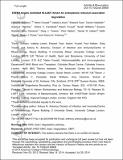Files in this item
Endoplasmic reticulum degradation–enhancing α-mannosidase–like protein 1 targets misfolded HLA–B27 dimers for endoplasmic reticulum–associated degradation
Item metadata
| dc.contributor.author | Guiliano, David B | |
| dc.contributor.author | Fussell, Helen | |
| dc.contributor.author | Lenart, Izabela | |
| dc.contributor.author | Tsao, Edward | |
| dc.contributor.author | Nesbeth, Darren | |
| dc.contributor.author | Fletcher, Adam J | |
| dc.contributor.author | Campbell, Elaine C | |
| dc.contributor.author | Yousaf, Nasim | |
| dc.contributor.author | Williams, Sarah | |
| dc.contributor.author | Santos, Susana | |
| dc.contributor.author | Cameron, Amy | |
| dc.contributor.author | Towers, Greg J | |
| dc.contributor.author | Kellam, Paul | |
| dc.contributor.author | Hebert, Daniel N | |
| dc.contributor.author | Gould, Keith | |
| dc.contributor.author | Powis, Simon J | |
| dc.contributor.author | Antoniou, Antony N | |
| dc.date.accessioned | 2015-10-26T00:11:16Z | |
| dc.date.available | 2015-10-26T00:11:16Z | |
| dc.date.issued | 2014-10-26 | |
| dc.identifier | 153166211 | |
| dc.identifier | 793369be-81b6-4626-988b-5c074038dc36 | |
| dc.identifier | 25132672 | |
| dc.identifier | 000344349500008 | |
| dc.identifier | 84938408657 | |
| dc.identifier.citation | Guiliano , D B , Fussell , H , Lenart , I , Tsao , E , Nesbeth , D , Fletcher , A J , Campbell , E C , Yousaf , N , Williams , S , Santos , S , Cameron , A , Towers , G J , Kellam , P , Hebert , D N , Gould , K , Powis , S J & Antoniou , A N 2014 , ' Endoplasmic reticulum degradation–enhancing α-mannosidase–like protein 1 targets misfolded HLA–B27 dimers for endoplasmic reticulum–associated degradation ' , Arthritis & Rheumatology , vol. 66 , no. 11 , pp. 2976-2988 . https://doi.org/10.1002/art.38809 | en |
| dc.identifier.issn | 2326-5191 | |
| dc.identifier.other | ORCID: /0000-0003-4218-2984/work/60195325 | |
| dc.identifier.uri | https://hdl.handle.net/10023/7688 | |
| dc.description | H.F is supported by an Arthritis Research (AR) UK project grant (17222). I.L is supported by ARUK studentship (17868) A.N.A is supported by an ARUK Fellowship (15293). E.C.C is supported by the Chief Scientist Office of the Scottish Government. D.N.H. is supported by US Public Health grant GM086874. G.J.T. is supported by a Wellcome Trust Senior Biomedical Fellowship. | en |
| dc.description.abstract | Objective HLA–B27 forms misfolded heavy chain dimers, which may predispose individuals to inflammatory arthritis by inducing endoplasmic reticulum (ER) stress and the unfolded protein response (UPR). This study was undertaken to define the role of the UPR‐induced ER‐associated degradation (ERAD) pathway in the disposal of HLA–B27 dimeric conformers. Methods HeLa cell lines expressing only 2 copies of a carboxy‐terminally Sv5‐tagged HLA–B27 were generated. The ER stress–induced protein ER degradation–enhancing α‐mannosidase–like protein 1 (EDEM1) was overexpressed by transfection, and dimer levels were monitored by immunoblotting. EDEM1, the UPR‐associated transcription factor X‐box binding protein 1 (XBP‐1), the E3 ubiquitin ligase hydroxymethylglutaryl‐coenzyme A reductase degradation 1 (HRD1), and the degradation‐associated proteins derlin 1 and derlin 2 were inhibited using either short hairpin RNA or dominant‐negative mutants. The UPR‐associated ERAD of HLA–B27 was confirmed using ER stress–inducing pharamacologic agents in kinetic and pulse chase assays. Results We demonstrated that UPR‐induced machinery can target HLA–B27 dimers and that dimer formation can be controlled by alterations to expression levels of components of the UPR‐induced ERAD pathway. HLA–B27 dimers and misfolded major histocompatibility complex class I monomeric molecules bound to EDEM1 were detected, and overexpression of EDEM1 led to inhibition of HLA–B27 dimer formation. EDEM1 inhibition resulted in up‐regulation of HLA–B27 dimers, while UPR‐induced ERAD of dimers was prevented in the absence of EDEM1. HLA–B27 dimer formation was also enhanced in the absence of XBP‐1, HRD1, and derlins 1 and 2. Conclusion The present findings indicate that the UPR ERAD pathway can dispose of HLA–B27 dimers, thus presenting a potential novel therapeutic target for modulation of HLA–B27–associated inflammatory disease. | |
| dc.format.extent | 3181096 | |
| dc.language.iso | eng | |
| dc.relation.ispartof | Arthritis & Rheumatology | en |
| dc.subject | EDEM1 | en |
| dc.subject | HRD1 | en |
| dc.subject | MHC class I degradation | en |
| dc.subject | XBP1 | en |
| dc.subject | RZ Other systems of medicine | en |
| dc.subject | BDC | en |
| dc.subject.lcc | RZ | en |
| dc.title | Endoplasmic reticulum degradation–enhancing α-mannosidase–like protein 1 targets misfolded HLA–B27 dimers for endoplasmic reticulum–associated degradation | en |
| dc.type | Journal article | en |
| dc.contributor.institution | University of St Andrews. School of Medicine | en |
| dc.contributor.institution | University of St Andrews. Biomedical Sciences Research Complex | en |
| dc.contributor.institution | University of St Andrews. School of Biology | en |
| dc.identifier.doi | https://doi.org/10.1002/art.38809 | |
| dc.description.status | Peer reviewed | en |
| dc.date.embargoedUntil | 2015-10-26 |
This item appears in the following Collection(s)
Items in the St Andrews Research Repository are protected by copyright, with all rights reserved, unless otherwise indicated.

